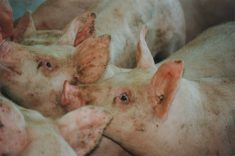Chicago Mercantile Exchange live cattle futures posted modest losses on Monday as worries about potential deliveries weighed, traders said.
Monday is the first notice day for live cattle deliveries against October futures that will expire on Oct. 31. The CME recently said those deliveries will not be affected by the partial U.S. government shutdown.
“October futures at 127.875 is a good bit higher than where cash cattle traded last week, which could prompt deliveries,” Doane Advisory Services economist Dan Vaught said.
October closed 0.175 cent per pound lower at 127.875 cents. December finished at 132.3 cents, down 0.125 cent.
Read Also

U.S. livestock: Cattle futures turn lower
Cattle futures on the Chicago Mercantile Exchange were weaker on Monday, ending a corrective bounce off nearby lows as high…
Futures were weakened by concerns that the lingering budget stalemate in Washington D.C. and the looming battle over the debt ceiling could ultimately hurt beef demand.
“We’re still geared toward a supply driven market. The thing that has us worried is a prolonged government shutdown and how that will affect meat movement,” KIS Futures vice president Lane Broadbent said.
And deferred-month live cattle futures’ premiums to last week’s cash cattle sales discouraged buyers.
Investors wait for this week’s cash cattle trade against the backdrop of tightening supplies and poor packer margins.
Last week, cattle in the central Midwest moved at $125 to $126 per hundredweight (cwt), which was steady to $1 lower compared to the week before, feedlot sources said.
Monday’s wholesale choice beef price, or cutout, gained a penny from Friday to $192.16/cwt. The select price was at $176.67, also up a penny, as quoted by analytical market research firm Urner Barry.
The firm estimated that beef packers on Monday processed 119,000 head of cattle, around 5,400 less than last year for the same period.
CME live cattle weakness and firm corn prices pressured feeder cattle contracts. Feedlots will buy fewer young cattle if corn prices move higher.
October feeder cattle ended 0.45 cent/lb. lower at 164 cents. November settled at 165.475 cents, down 0.475 cent.
Most hogs up on supply expectations
Other than CME hog spot October futures, other contracts settled firm in anticipation of a brief supply shortage later this winter, traders said.
Bullish investors contend that the U.S. government’s recent quarterly hog report did not account for losses from the porcine epidemic diarrhea virus (PEDv), which is deadly to baby pigs.
Some traders sold spot October and bought deferred months because of the lack of USDA cash price data needed to help determine the spot-month settlement on Oct. 14.
In the meantime, the partial government closure forced the country’s leading pork packers to change the methods they use to determine what price to pay producers for hogs.
Cash hog prices were mixed on Monday in the terminal and direct cash markets, hog buyers and private industry sources said.
Packers on Monday processed an estimated 429,000 hogs, 3,000 less than last week and down 1,000 head from a year ago for the same period, as estimated by Urner Barry.
Spot October finished at 91.6 cents/lb., down 0.25 cent.
Most-actively traded December closed up 0.25 cent to 87.875 cents and February finished at 90.225 cents, 0.375 cent higher.
— Theopolis Waters reports on livestock futures markets for Reuters from Chicago.














